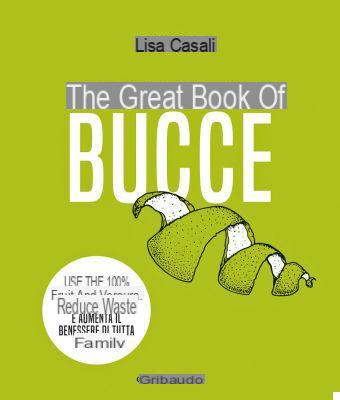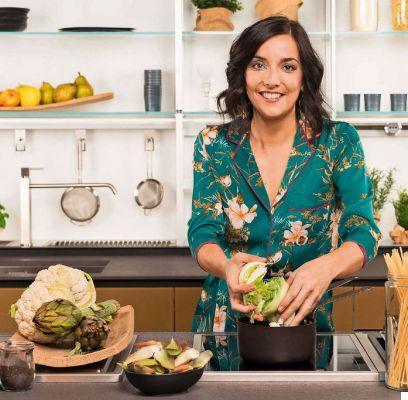Every day, between cores, leaves, fibrous parts and especially peels, about 50% of fruit and vegetables ends up in the garbage. Think about how much of pumpkins, potatoes, carrots, celery, broccoli and citrus fruits we throw in the humid container. Yet not everything is to be thrown away.
Lisa Casali, environmental scientist and author of The Big Book of Peels (Gribaudo, € 19,90) has spent the last fifteen years studying how to minimize waste of fburp and vegetables in the kitchen, triggering a revolution that can have a huge positive impact on health, wallets and the environment, thanks to the reduction of waste and the elimination of waste in the kitchen. 
The peels are chests of nutrients
«He was unstoppable use 100% every fruit and vegetable we buy, we could double the yield of our spending e halve your monthly budget», Says Lisa Casali. But it's not just a question of savings.
Without knowing it, every time we peel a vegetable we deprive ourselves of the richest parts of phytocompounds. To these plant substances, which are naturally produced by plants to defend themselves from environmental stress and are therefore concentrated in the most attackable parts such as peels and external leaves, science also recognizes an important role for our health. Depending on the type, these phytocompounds can perform various beneficial actions.
La Vitamin C which is concentrated in the fruit skins (that of apple, for example, has up to 700% more than the pulp) and in the more fibrous parts of the broccoli has an antioxidant effect which, in the human body, is able to fight the free radicals and to protect cells from oxidative stress. The carotenoids contained in the carrot and pumpkin skins (the pumpkin skin contains up to 150% more than the pulp) are able to strengthen ours immune system. While the flavonoids and polyphenols contained in the external parts of cabbage, onions, apples and citrus fruits are able to regulate hormones, modulandoli.
«L’albedo, or that inner white part of the citrus peel, and the lemon peel contain over 300% more flavonoids compared to juice and pulp, the parts that, of a lemon, we consider noble. And the same is true oforange, whose peel contains about 350% more polyphenols than the pulp (349% in the conventional, 354% in the organic) », explains the expert.
The amount of pesticides detected is minimal
"When we think about the skins and the external parts", continues Lisa Casali (in the photo) "we often believe that they are tastier and richer in nutrients. only if they are organic. Also, many times we think that, buying them in a traditional supermarket, they are full of pesticides. The studies I conducted with Altroconsumo show the contrary, and they provided us with data that amazed me too: in all the analyzed samples of fruit and vegetables from the village the values found were much lower than the legal limits (less than 0,01% in the conventional, no trace in the bio) ". And if we really don't feel safe, the scientist recommends washing the products well under water, rubbing the peel with a natural fiber brush, but avoiding the so common use of bicarbonate:
"Contrary to popular belief, bicarbonate in addition to not taking away any pesticides from the fruit (if they were used they are not only on the peel but also ended up in the pulp), binding to phytonutrients depletes the outermost parts of many beneficial substances, making their consumption substantially vain ".
If you use peels & Co. you protect the planet
But it's not just for our health that we need to learn to use 100% fruit and vegetables that we buy. "The way we eat is not a private matter," Casali continues. «What happens in our kitchen is not a mere subject of home economics: it is the pivot of environmental sustainability society.
Every time you throw away the outer leaves and stems of an artichoke or the pods of peas and broad beans (vegetables where the waste is 80%), you create two kinds of "waste": 80% of environmental resources also end up in the trash (water, soil, transport-related emissions) that were used to produce that vegetable and create an enormous mass of waste (only a part of the waste that you recycle becomes compost), which will be managed with a new waste of resources ".
And the picture is even more serious: the estimates of fruit and vegetable waste in home cooking are underestimated. “Statistics say that 30% of the food that every family in the country does not use annually is fruit and vegetables: a huge figure, if we think that this figure refers only to those vegetables that we leave wither forgotten in a corner of the refrigerator, and does not take into account that 50% of "less noble" skins and parts that, considered "waste", end up in the garbage, ”adds Casali.
Waste as a raw material
Learning to cook even the most leathery peels, cores, pods and outer leaves, therefore becomes indispensable for a cooking without wasting nutrients and environmental resources. But using these "scraps" in the kitchen is not the only use we can make of them: for some time now, there have been startups engaged in recovery and recycling of these waste parts.
This is the case of Orange Fiber, a company in the country that uses the processing residues of the citrus processing industry to create sustainable fabrics, already used by big brands such as Ferragamo and H&M. And it is the case of the CNR of Catania, whose researchers have developed a food film made only with pectin of the oranges of Catania, and of Smart Materials, research group ofInstitute of Technology of Genoa which, in collaboration with the Genoa Market and Ascom Confcommercio, exploits vegetable waste to create 100% eco-sustainable and biodegradable containers.


























